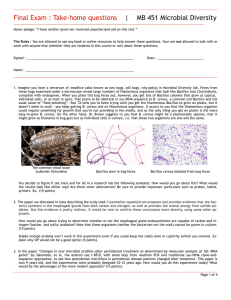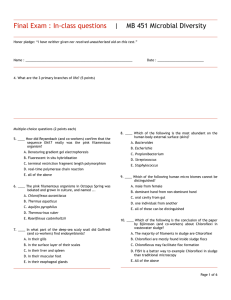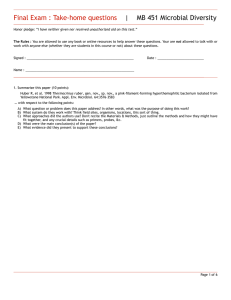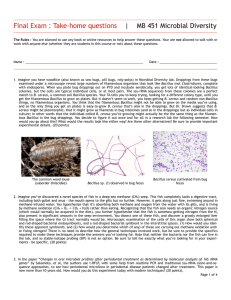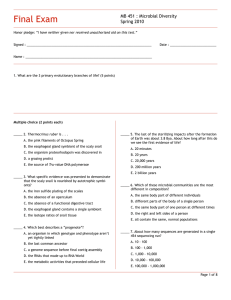! Final Exam : In-class questions
advertisement
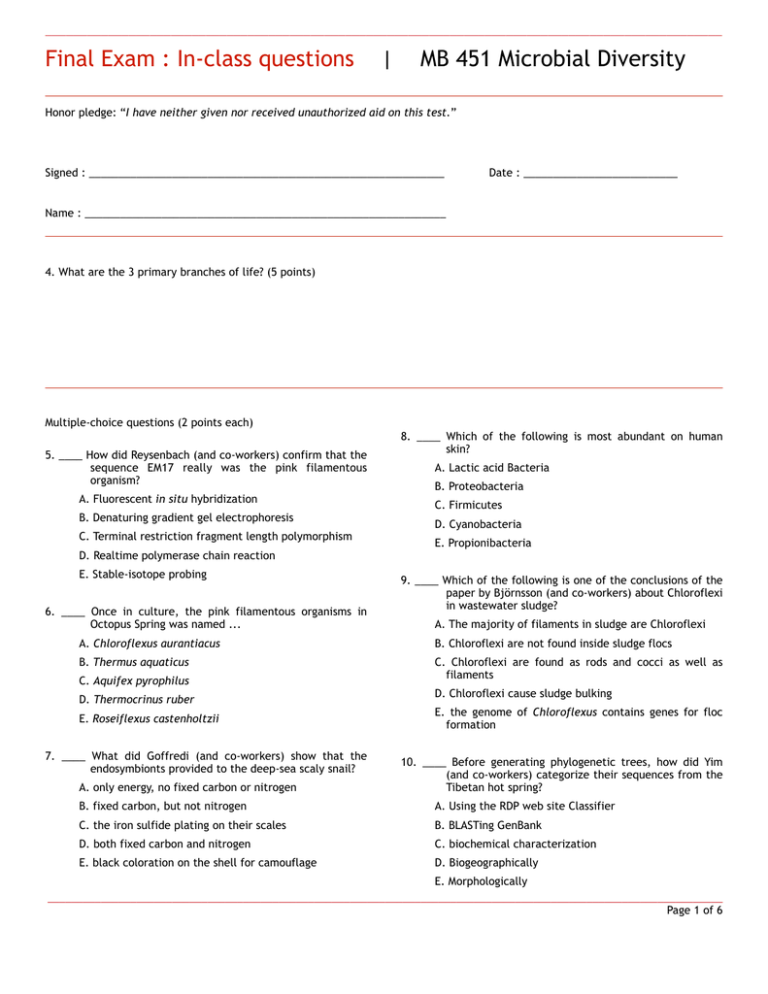
_________________________________________________________________________________________________ Final Exam : In-class questions | MB 451 Microbial Diversity ! Honor pledge: “I have neither given nor received unauthorized aid on this test.” ! ! ! Signed : ____________________________________________________________ Date : __________________________ Name : _____________________________________________________________ ! ! ! ! ! ! ! ! ! 4. What are the 3 primary branches of life? (5 points) ! Multiple-choice questions (2 points each) 5. ____ How did Reysenbach (and co-workers) confirm that the sequence EM17 really was the pink filamentous organism? 8. ____ Which of the following is most abundant on human skin? A. Lactic acid Bacteria B. Proteobacteria A. Fluorescent in situ hybridization C. Firmicutes B. Denaturing gradient gel electrophoresis C. Terminal restriction fragment length polymorphism D. Realtime polymerase chain reaction ! E. Stable-isotope probing 6. ____ Once in culture, the pink filamentous organisms in Octopus Spring was named ... D. Cyanobacteria ! 9. ____ Which of the following is one of the conclusions of the paper by Björnsson (and co-workers) about Chloroflexi in wastewater sludge? A. The majority of filaments in sludge are Chloroflexi A. Chloroflexus aurantiacus B. Chloroflexi are not found inside sludge flocs B. Thermus aquaticus C. Chloroflexi are found as rods and cocci as well as filaments C. Aquifex pyrophilus D. Chloroflexi cause sludge bulking D. Thermocrinus ruber ! E. Propionibacteria E. Roseiflexus castenholtzii 7. ____ What did Goffredi (and co-workers) show that the endosymbionts provided to the deep-sea scaly snail? A. only energy, no fixed carbon or nitrogen ! E. the genome of Chloroflexus contains genes for floc formation 10. ____ Before generating phylogenetic trees, how did Yim (and co-workers) categorize their sequences from the Tibetan hot spring? B. fixed carbon, but not nitrogen A. Using the RDP web site Classifier C. the iron sulfide plating on their scales B. BLASTing GenBank D. both fixed carbon and nitrogen C. biochemical characterization E. black coloration on the shell for camouflage D. Biogeographically E. Morphologically __________________________________________________________________________________________________________________ Page 1 ! of 6 ! _________________________________________________________________________________________________ 11. ____ What was the primary method used by Sakamoto (and co-workers) to to compare oral microbial populations before and after periodontal treatment? 13. ____ Proteorhodopsin is a ... A. light-driven chloride pump B. light-activated calcium channel A. Fluorescent in situ hybridization C. light sensing transducer B. Denaturing gradient gel electrophoresis D. light-driven proton pump C. Terminal restriction fragment length polymorphism D. Realtime polymerase chain reaction ! E. Stable-isotope probing 12. ____ Which of the following unicellular eukaryotes was found by Moreno (and co-workers) to preferentially feed on autotrophic ammonia oxidizing microbes in wastewater sludge? ! 14. Which if the following best describes how Thermotoga maritime makes a living? A. by fermentation B. by aerobic respiration C. by anaerobic respiration A. Epistylus B. Chaos C. Arcella D. Spumella E. Hartmanella ! E. none of the above D. by photosynthesis ! ! E. by sulfur oxidation ! ! Short-answer questions (5 points each) 15. Describe one of the two major approaches used to link the specific organisms in an environment to specific processes known to take place in that environment. In other words, one method used to link the identity (phylotype) of an organism to it’s function (phenotype). ! ! ! ! ! __________________________________________________________________________________________________________________ Page 2 ! of 6 ! _________________________________________________________________________________________________ 16. Describe one way Nelson and colleagues tried to identify “foreign” genes, i.e. those acquired by horizontal transfer, in the genome of Thermotoga maritima. ! ! ! ! ! ! ! ! ! ! ! ! ! ! ! ! ! ! ! ! ! ! 17. Describe the most interesting thing you learned from any of the papers we reviewed in class. Make sure to include why you think this is interesting - what does it mean to you? ! __________________________________________________________________________________________________________________ Page 3 ! of 6 ! _________________________________________________________________________________________________ Essay question (10 points) ! 18. Describe in detail any paper we’ve discussed in this course. You are allowed to use papers we reviewed in the Discussion session if you wish. Be sure to include the purpose, approach, methods, results, and conclusion. __________________________________________________________________________________________________________________ Page 4 ! of 6 ! _________________________________________________________________________________________________ USE THIS PAGE TO FINISH ANY ANSWERS YOU’RE BEING LONG-WINDED ABOUT __________________________________________________________________________________________________________________ Page 5 ! of 6 ! _________________________________________________________________________________________________ Papers reviewed in class: • Reysenbach AL, Wickham GS & Pace NR 1994 Phylogenetic analysis of the hyperthermophilic pink filament community in Octopus Spring, Yellowstone National Park. Appl. Env. Microbiol. 60:2133-2199 • Huber R, et al. 1998 Thermocrinus ruber, gen. nov., sp. nov., a pink-filament-forming hyperthemophilic bacterium isolated from Yellowstone National Park. Appl. Env. Microbiol. 64:3576-3583 • Goffredi SK, Waren A, Orphan VJ, Van Dover CL & Vrijenhoek RC 2004 Novel forms of structural integration between microbes and a hydrothermal vent gastropod from the Indian Ocean. Appl Env Microbiol 70:3082-3090 • Costello EK, Lauber CL, Hamady M, Fierer N gordon JI & Knight R 2009 Bacterial community variation in human body habitats across space and time. Science 326:1694-1697 • Björnsson L, Hugenholtz P, Tyson GW & Blackall LL. 2002 Filamentous Chloroflexi (green non-sulfur bacteria) are abundant in wastewater treatment processes with biological nutrient removal. Microbiol. 148:2309-2318. • Yim LC, Hongmei J, Aitchison JC & Pointing SB 2006 Highly diverse community structure in a remote central Tibetan geothermal spring does not display monotonic variation to thermal stress. FEMS Microbiol Ecol. 57:80-91 • Sakamoto M, Huang Y, Ohnishi M, Umeda M, Ishikawa I & Benno Y. 2004 Changes in oral microbial profiles after peridontal treatment as determined by molecular analysis of 16S rRNA genes. J. Med. Microbiol. 53:563-571. • Moreno Am, Matz C, Kjelleberg S & Manefield M 2010 Identification of ciliate grazers of autotrophic Bacteria in ammonia-oxidizing activated sludge by RNA stable isotope probing. AEM 76:2203-2211 • Beja O, et al. 2000 Bacterial rhodopsin: Evidence for a new type of phototrophy in the sea. Science 289:1902-1906. ! Papers reviewed in the Discussion sessions this semester (you can use these if you wish): • Murgia C, Pritchard JK, Kim SY, Fassati A, and RA Weiss 2006 Clonal origin and evolution of a transmissible cancer. Cell 126:477-487 • Wolfe-Simon F, et al. 2010 A bacterium that can grow by using arsenic instead of phosphorous. ScienceXpress 10.1126 • Drancourt, M., Aboudharam, G., Signoli, M., Dutour, O., and Raoult, D. 1998 Detection of 400-year-old Yersinia pestis DNA in human dental pulp: An approach to the diagnosis of ancient septicemia. Proc. Natl. Acad. Sci. USA 95:12637-12640. • Drancourt, et al., 2004 Genotyping, Orientalis-like Yersina pestis, and Plague Pandemics. Emerg Inf Diseases 10:1585 • Rault D, et al. 2008 Nanobacteria are mineralo fetuin complexes. PLOS Pathogens 4:e41 • Soto C. 2011 Prion Hypothesis: the end of the controversy? TiBS 36:151 • Giovannoni SJ, et al. 2005 Genome streamlining in a cosmopolitan oceanic bacterium. Science 309:1242 • Fierer N, Hamady M, Lauber CL and R Knight 2008 The influence of sex, handedness, and washing on the diversity of hand surface bacteria. PNAS 105:17994-17999 __________________________________________________________________________________________________________________ Page 6 ! of 6 ! __________________________________________________________________________________________________________________ Final Exam : Take-home questions ! | MB 451 Microbial Diversity Honor pledge: “I have neither given nor received unauthorized aid on this test.” ! The Rules : You are allowed to use any book or online resources to help answer these questions. Your are not allowed to talk with or work with anyone else (whether they are students in this course or not) about these questions. ! ! Signed : ____________________________________________________________ Date : __________________________ Name : _____________________________________________________________ ! ! 1. Imagine you have a terrarium of woodlice (also known as sow bugs, pill bugs, or roly-polys) in Microbial Diversity lab. Feces from these bugs examined under a microscope reveal large numbers of filamentous organisms that look like Bacillus, complete with endospores. When you plate this bug feces out, however, you get lots of Bacillus colonies that grow as typical, individual cells, or at most in pairs, that prove to be identical in ssu-rRNA sequence to B. cereus, a common soil Bacillus and a frequent cause of “food poisoning”. Your TA tells you to keep trying until you get the filamentous Bacillus to grow on plates, but it doesn’t seem to work - you keep getting B. cereus and no filamentous organisms. It occurs to you that the filamentous organism could require something for growth that you’re not providing in the media, and so the only thing you get on plates is easy-to-grow B. cereus. On the other hand, Dr. Brown suggests to you that B. cereus might be a pleomorphic species, that it might grow as filaments in bug guts but as individual cells in culture, i.e. that these two organisms are one and the same. ! ! ! The common wood louse (suborder Oniscidea) ! Bacillus seen in bug feces Bacillus cereus isolated from bug feces You decide to figure it out once and for all in a research lab the following semester. How would you go about this? What would the results look like either way? Be sure to provide important particulars such as probes, labels, primers, controls, &c. (15 points) 2. The paper we discussed in class describing the scaly snail Crysomallon squamiferum proposes and provides evidence that the bacterial symbiont in the esophageal glands fixes both carbon and nitrogen, as well as provides the animal energy from sulfide oxidation. But this evidence is pretty indirect, it would be nice to confirm these conclusions more directly, using some other approach. How would you go about trying to determine whether or not the esophageal gland endosymbionts are capable of carbon and nitrogen fixation, and sulfur oxidation? Note that these organisms (neither the bacterium nor the snail) cannot be grown in culture/captivity in the lab. (15 points) Stable-isotope probing probably won’t work in this experiment even if you could keep the snails alive in captivity (which you cannot). Explain why SIP would not be a good option (5 points). ! 3. In the paper “Changes in oral microbial profiles after periodontal treatment as determined by molecular analysis of 16S rRNA genes” by Sakamoto, et al, the authors use t-RFLP, with some help from realtime PCR and traditional ssu-rRNA clone-and-sequence approaches, to see how periodontal microflora in periodontal disease patients changed after treatment. This paper is now 10 years old, and the experiments were probably designed at least 12 years ago. How would you do this experiment today? What would be the advantages of the more modern approach? (15 points). __________________________________________________________________________________________________________________ Page 1 ! of 4 ! __________________________________________________________________________________________________________________ Question #1 Answer page ! Don’t Panic! __________________________________________________________________________________________________________________ Page 2 ! of 4 ! __________________________________________________________________________________________________________________ Question #2 Answer page __________________________________________________________________________________________________________________ Page 3 ! of 4 ! __________________________________________________________________________________________________________________ Question #3 Answer page ! ! ! __________________________________________________________________________________________________________________ Page 4 ! of 4 !
